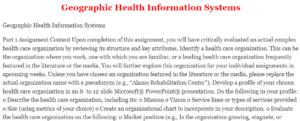Geographic Health Information Systems
Geographic Health Information Systems
Geographic Health Information Systems
Part 1 Assignment Content Upon completion of this assignment, you will have critically evaluated an actual complex health care organization by reviewing its structure and key attributes. Identify a health care organization. This can be the organization where you work, one with which you are familiar, or a leading health care organization frequently featured in the literature or the media. You will further explore this organization for your individual assignments in upcoming weeks. Unless you have chosen an organization featured in the literature or the media, please replace the actual organization name with a pseudonym (e.g., “Alamo Rehabilitation Center”). Develop a profile of your chosen health care organization in an 8- to 12-slide Microsoft® PowerPoint® presentation.
Do the following in your profile: o Describe the health care organization, including its: o Mission o Vision o Service lines or types of services provided o Size (using metrics of your choice) o Create an organizational chart to incorporate in your description. o Evaluate the health care organization on the following: o Market position (e.g., Is the organization growing, stagnate, or atrophying?) o Culture (e.g., Is the organization viewed as an innovator or a follower? What is the workplace culture?) o Application of Triple Aim (e.g., How is the Triple Aim important to this organization’s future?) Include a title slide, introduction slide, conclusion slide, and references. Provide voice-over and/or speaker’s notes for each slide. Part 2 Student Response 1: Student response 1: Review the classmates’ posts and respond to at least one in a minimum of 150 words. Explain why you agree or disagree. Then, share an example from your professional experience to support your assertions. Healthcare organizations are considered to be complex adaptive systems (CAS). Researchers Ratnapalan and Lang defined healthcare as a complex adaptive system as they are comprised of networks of interacting, independent entities with a common goal and adapting structures and hierarchies. They further describe that the simple patient-and-physician model no longer fits as healthcare has become increasingly complex with many networks and organizations that coordinate care through multiple providers and payer sources.(Ratnapalan & Lang, 2020). In other words, healthcare can be examined by the interconnectedness and interaction of multiple subsystems that are dynamically changing in various environments. To illustrate healthcare organizations as a CAS, nursing homes provide a great example. Nursing homes coordinate care through many providers including nursing staff, rehab staff, social workers, dieticians, and physicians which all have a common goal for high patient outcomes and these providers are also working with many different payer sources to provide achieve such outcomes. The characteristics of this organization that make it a CAS include the high degree of connectivity between entities such as the providers, payer sources, and other organizations involved in the patient’s care. In addition, the unbounded, nonlinear, and dynamic nature of nursing homes classifies them as CAS. Nursing homes also require high-quality energy in terms of money and manpower to sustain themselves and they are constantly changing and adapting. This differs from a simple system as simple systems have a linear trajectory with predictable outcomes and can be viewed by examining entities in isolation. As a rehabilitation provider in a nursing home, I agree that they should be viewed as a CAD due to the interconnectedness of all providers. A study conducted by Anderson, Issel, and McDaniel examined nursing homes further as a complex adaptive system applying complexity science to determine the relationship between management practices and outcomes by controlling for various subsystems (Anderson, Issel, McDaniel, 2003). Furthermore, Kiviliene and Blazeviciene hypothesize that because nursing and complex adaptive systems are open, non-linear, dynamic, and interactive with many variables as well as requiring resilience, collaboration, structure and flow, spontaneity, and engaging the unknown, using CAS as a model for nursing will improve outcomes (Kiviliene & Blazeviviene, 2019). \ References Anderson, R. A., Issel, L. M., & McDaniel Jr, R. R. (2003). Nursing homes as complex adaptive systems: relationship between management practice and resident outcomes. Nursing research, 52(1), 12. Kiviliene, J., & Blazeviciene, A. (2019). Review of complex adaptive systems in nursing practice. Journal of Complexity in Health Sciences, 2(2), 46-50. Ratnapalan, S. & Lang, D. (2020). Health Care Organizations as Complex Adaptive Systems. The Health Care Manager, 39 (1), 18-23. doi: 10.1097/HCM.0000000000000284. Student Response 2: Student response 1: Review the classmates’ posts and respond to at least one in a minimum of 150 words. Explain why you agree or disagree. Then, share an example from your professional experience to support your assertions. After going through this week’s readings, the topic that I found the most interesting and resonated with me is the Triple Aim Framework. The Triple Aim framework assists healthcare organizations in designing improvement programs. Triple Aim offers a comprehensive system, of measurement that provides standardized metrics to assess equitable care leading to population health improvements (Miranda et al., 2013). According to Lewis (2014), “The term Triple Aim refers to the simultaneous pursuit of improving the patient experience of care, improving the health of populations, and reducing the per capita cost of health care”. The benefits of Triple Aim can be present for patients, healthcare organizations, and the overall population. From a patient’s perspective, the Triple Aim framework can reduce complexities of care, create coordination of care, and reduce illness burdens. For healthcare organizations, the triple aim can provide a competitive advantage and reduce indirect costs of care. Finally, the overall population can benefit from the Triple Aim framework by better identifying care needs, reducing public healthcare budgets, and reallocating funds to increase community vitality and well-being (Lewis, 2014). Having worked in healthcare for several years, I am always striving to constantly make improvements to my patient’s care. Healthcare organizations rely on patients to continue operations. Patients rely on healthcare organizations to fulfill health-related needs. Patient and patient experiences can drive the success of an organization. I think that enhanced patient experience can lead to enhanced patient care. I have witnessed healthcare organizations prioritize their fiscal needs or less vital matters before their patient’s needs. In the organization I currently work in, patient experience and care are our top priority, through this type of care, patient experiences are naturally enhanced. Reference Lewis, N. (2014). A Primer on Defining the Triple Aim. https://www.ihi.org/communities/blogs/aprimer-on-defining-the-triple-aim Miranda, M. L., Ferranti, J., Strauss, B., Neelon, B., & Califf, R. M. (2013). Geographic Health Information Systems: A Platform To Support The “Triple Aim.” Health Affairs, 32(9), 1608– 1615. https://doi.org/10.1377/hlthaff.2012.1199
Use the following coupon code :
NursesHomework


